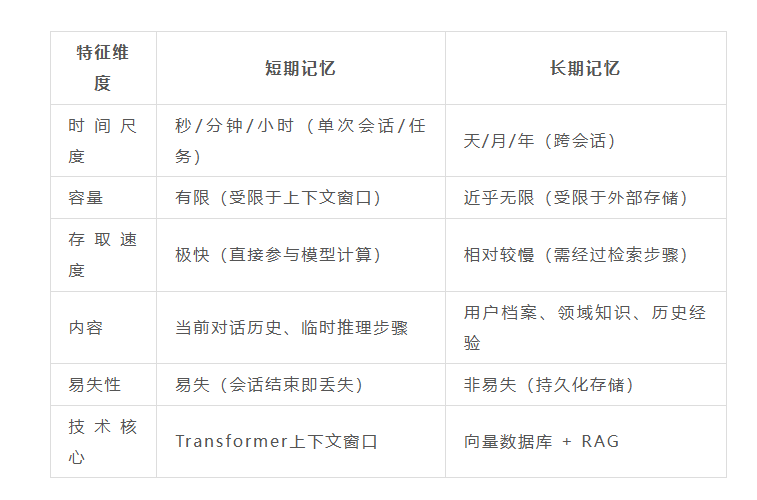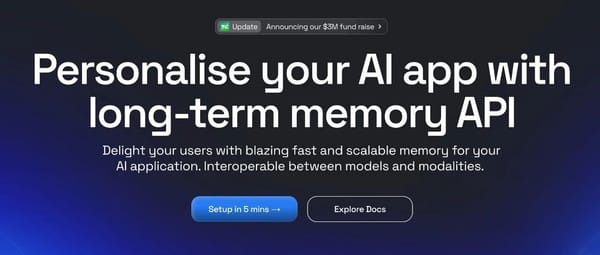# Understanding Short-Term vs Long-Term Memory in AI Agents
In artificial intelligence, **memory** is crucial for the intelligence, coherence, and usefulness of an AI Agent.
This guide explores the differences between **short-term** and **long-term** memory, and how they work together to power intelligent systems.
---
## What is an AI Agent?
An **AI Agent** is an autonomous system capable of:
- **Perceiving** its environment
- **Reasoning** about information
- **Taking actions** to achieve specific goals
**Memory** gives the Agent *continuity* and *personality.*
Without it, interactions are isolated and stateless – like suffering from digital amnesia.
In designing Agent architectures, memory is often split into:
- **Short-term memory** — like human working memory
- **Long-term memory** — like human experience archives
---
## 1. Short-Term Memory: The Workbench of Consciousness
### 1.1 Definition & Core Features
Short-term memory is **temporary information storage** during a current task or dialog. It is analogous to a CPU’s RAM or human working memory.
Key characteristics:
- **Timely & context-dependent**
Tracks immediate interactions (e.g., recent user utterances)
- **Limited capacity**
Bound by the model’s context window (e.g., 4K–200K tokens)
- **Fast access**
Active, instantly available without retrieval steps
- **Volatile**
Overwritten or erased when sessions end
---
### 1.2 Technical Implementation
Common technical foundations:
- **Transformer context window**
Self-attention spans only the most recent tokens; when exceeded, older context is dropped.
- **System prompts & few-shot examples**
These define the initial state for dialogue, living inside the short-term window.
- **Chain-of-thought reasoning**
Step-by-step reasoning persists in the context until task completion.
---
### 1.3 Application Scenarios
Short-term memory is key for:
- **Multi-turn dialog agents**
E.g., Booking travel with coherent follow-ups
- **Task decomposition**
Holding decomposed steps until task finishes
- **Code writing/debugging**
Remembering variable names and logic during development
- **Pronoun/context resolution**
Interpreting “it,” “that,” or “the other one” based on recent conversation
---
## 2. Long-Term Memory: The Library of Experience
### 2.1 Definition & Core Features
Long-term memory persists across sessions, storing **knowledge and experiences** similar to human autobiographical and factual memory.
Key differences from short-term memory:
- **Persistent & cross-context**
Accessible across sessions
- **Virtually unlimited capacity**
Expandable via external storage
---
### 2.2 Retrieval & Usage
- **On-demand retrieval**
Not always active; recalled when needed
- **Non-volatile**
Retains personal history, exclusive knowledge
---
### 2.3 Technical Implementation
Core components:
- **Vectorization & vector databases**
Embed unstructured data (text/images) → store in high-dimensional vector space → retrieve via similarity search
- **Traditional databases**
Persist structured data (user profiles, transaction logs)
- **Retrieval-Augmented Generation (RAG)**
Fetch relevant data from long-term memory, inject into context window
- **Reinforcement learning experience replay**
Save (state, action, reward) tuples for retraining & strategy retention
---
### 2.4 Application Scenarios
Long-term memory enables:
- **Personalized assistants**
Remember preferences & routines
- **Enterprise knowledge base Q&A**
Instant answers from internal documents
- **Companion robots**
Store shared stories & emotional histories
- **Skill/tool proficiency**
Retain API usage or bug fixes
---
## 3. Core Differences & Synergy
| Feature | Short-Term Memory | Long-Term Memory |
|-------------------------|--------------------------------------|--------------------------------------|
| Duration | Temporary (session bound) | Persistent across sessions |
| Capacity | Limited (context window) | Virtually unlimited |
| Access | Instant | Requires retrieval |
| Volatility | High | Low |
| Storage medium | In-model context window | External database/vector store |
---
### How They Work Together: The RAG Example
1. **Trigger:** User asks “What is our latest leave policy?”
2. **Retrieve (Long-term memory):** Query vector matches policy document excerpts
3. **Inject (Short-term memory):** Retrieved text loaded into model’s context window
4. **Generate:** LLM produces precise answer using enriched context
**Short-term memory** acts as a focused processing workspace,
**Long-term memory** as a vast knowledge reservoir.
---
## 4. Future Outlook & Challenges
Challenges ahead:
- **Short-term memory limits** — Context window size vs. cost & latency
- **Long-term retrieval quality** — Accuracy, freshness, conflict resolution
- **Memory abstraction/compression** — Storing concepts, not just raw data
- **Security & privacy** — Safeguarding sensitive stored information
---
### Opportunities
Advanced frameworks may integrate:
- Context compression
- Retrieval optimization
- Multi-platform publishing
Example: [AiToEarn官网](https://aitoearn.ai/)
An open-source ecosystem connecting AI content generation, analytics, ranking, and distribution across Douyin, Kwai, WeChat, Bilibili, Xiaohongshu, Facebook, Instagram, LinkedIn, Threads, YouTube, Pinterest, X (Twitter).
---
## 5. Summary
- **Short-term memory** = agility & immediate reasoning
- **Long-term memory** = continuity & accumulated intelligence
- Combining both enables Agents to be **coherent now** and **smarter over time**
**Key takeaway:**
Mastering both memory types is essential for building credible, capable, and evolving AI Agents.
---
**———— / E N D / ————**





